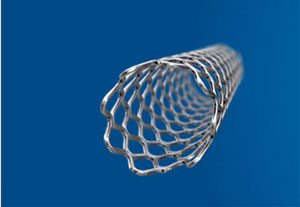- Home
- Editorial
- News
- Practice Guidelines
- Anesthesiology Guidelines
- Cancer Guidelines
- Cardiac Sciences Guidelines
- Critical Care Guidelines
- Dentistry Guidelines
- Dermatology Guidelines
- Diabetes and Endo Guidelines
- Diagnostics Guidelines
- ENT Guidelines
- Featured Practice Guidelines
- Gastroenterology Guidelines
- Geriatrics Guidelines
- Medicine Guidelines
- Nephrology Guidelines
- Neurosciences Guidelines
- Obs and Gynae Guidelines
- Ophthalmology Guidelines
- Orthopaedics Guidelines
- Paediatrics Guidelines
- Psychiatry Guidelines
- Pulmonology Guidelines
- Radiology Guidelines
- Surgery Guidelines
- Urology Guidelines
Breakthrough : Slimmest and Smallest Drug-Eluting Stent in the market

A new stent which is the smallest sized Drug-Eluting Stent DES has been approved by the U.S. Food and Drug Administration (FDA) .The slimmest stent named Resolute Onyx(TM) 2.0 mm has been specifically designed for small vessels .
The Resolute Onyx DES platform is the first-and-only DES to feature Core Wire Technology, an evolution of Continuous Sinusoid Technology (CST). CST is a unique Medtronic method of stent manufacturing, which involves forming a single strand of cobalt alloy wire into a sinusoidal wave to construct a stent. Core Wire Technology enables thinner struts while maintaining structural strength and visibility.
The new stent is intended to help interventional cardiologists treat patients with coronary artery disease (CAD) who have small vessels often untreatable with larger stent technologies during the percutaneous coronary intervention (PCI). It is estimated that approximately 65 percent of smaller vessels (<= 2.25 mm) are in critical locations of the heart, making them significant lesions to treat.
"Patients with lesions in small vessels or complex vasculatures can present unique challenges for physicians during PCI procedures," said Matthew J. Price, M.D., an interventional cardiologist at Scripps Clinic in La Jolla, Calif., and national principal investigator of the RESOLUTE ONYX 2.0 mm Clinical Study, which supported the recent FDA approval. "The Resolute Onyx 2.0 mm DES is an extremely deliverable stent that, when needed, can be post-dilated to 3.25 mm to treat lesions in difficult-to-reach areas of the heart."
The first-and-only 2.0 mm DES size available in the U.S., the newly approved stent joins the unique Resolute Onyx 4.5- and 5.0-mm DES to provide physicians with the broadest DES size matrix available, expanding treatment options for patients with the smallest coronary vessels to the largest, from the simplest of anatomies to the complex. In addition, the stent is engineered with the lowest crossing profile of any DES (less than 1 mm) enabling exceptional deliverability. Once delivered, the Resolute Onyx 2.0 mm DES is engineered to expand from 2.0 mm to the maximum labeled expansion diameter of 3.25 mm.
"Furthering our core objective of developing technologies that address unmet patient needs, the introduction of the Resolute Onyx 2.0 mm DES allows physicians to expand treatment options for patients with smaller vessels," said Dave Moeller, vice president and general manager of the Coronary and Renal Denervation business, which is part of the Cardiac and Vascular Group at Medtronic. "The Resolute Onyx DES is an incredibly deliverable product that incorporates various design enhancements enabling physicians to optimize treatment for a wide range of patients."
The Resolute Onyx 2.0 mm DES is supported by the RESOLUTE ONYX 2.0 mm Clinical Study, which was presented at the 2017 EuroPCR Annual Meeting and simultaneously published in the Journal of the American College of Cardiology (JACC): Cardiovascular Intervention. In the study, the Resolute Onyx DES met its pre-specified performance goal with low target lesion failure (5 percent), low target lesion revascularization (2 percent), no episodes of stent thrombosis and no cardiac death at 12 months.
During the study, 101 patients from the United States and Japan underwent the trial who had de novo lesions < 27 mm in length with a reference vessel diameter of 2.0 mm or greater, but less than 2.25 mm, by visual estimation. All underwent FFR to confirm significant stenoses. The primary endpoint of target lesion failure was 5 percent at 1 year, which was significantly lower than the performance goal of 19 percent. Target lesion revascularization (TLR) was only 2 percent at 1 year, and there were three target-vessel MIs and no instances of stent thrombosis.
The approval is given for Resolute Onyx(TM) 2.0 mm Drug-Eluting Stent (DES) to Medtronic plc.
To read the study click on the link below :
DOI: 10.1016/j.jcin.2017.05.004

Disclaimer: This site is primarily intended for healthcare professionals. Any content/information on this website does not replace the advice of medical and/or health professionals and should not be construed as medical/diagnostic advice/endorsement or prescription. Use of this site is subject to our terms of use, privacy policy, advertisement policy. © 2020 Minerva Medical Treatment Pvt Ltd